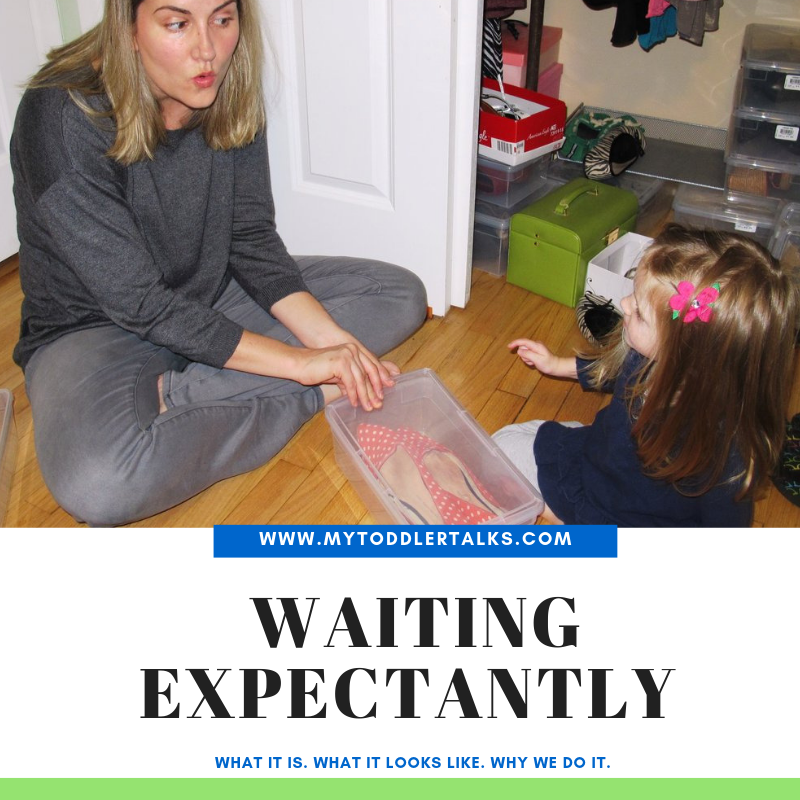Waiting Expectantly: What it is. What it looks like. Why we do it.
Waiting Expectantly: What it is. What it looks like. Why we do it. What do you do to increase your toddler’s ability to initiate communication?
Take a moment and think about it….
...are some of you thinking - Ask questions?
Am I catching some of you in a flashback to the time when you asked:
“Hey sweetie, what do you want to eat?”
Instead of receiving a verbal response (“Turkey!”) you were ignored or met with a look or an “uh uh” and a point to the cupboards? If this is the case, especially if your toddler is pointing, don’t be discouraged.
You’re certainly allowed to ask your toddler questions.
Yes, yes, yes, I know, we early interventionists frown upon asking too many questions for all these reasons (click this post to read more). However, asking questions like, “How was your day” or “Are you excited to see grandma and grandpa” are good for social development because such questions model appropriate conversational skills. Although if your little one has a language delay I wouldn’t necessarily expect a proper verbal response. I promise to write another post on social communication development. In the meantime I’m focusing on how to encourage verbal INITIATION from toddlers via this ONE strategy - waiting expectantly.
Many posts back, I wrote about How Pausing Improves Communication.
Waiting expectantly and pausing are two skills that go hand-in-hand; together they’re a powerful combo.
In My Toddler Talks, I encourage parents to wait expectantly. I briefly explain what it is on page 13:
“Show that you are waiting expectantly by raising your eyebrows, smiling, and opening your mouth.”
Why should we pause and wait expectantly?
Doing so helps your child to realize that he needs to communicate, verbally or non-verbally, to get what he wants. If we, adults, are always anticipating a child’s needs and wants or prompting constantly by saying: “Say more”, “say truck” or “say ball” the child may become reliant or dependent on the prompt. This is especially the case for children with autism.
Pausing and waiting expectantly gives your child the POWER to decide how or when he or she wants to communicate. This may be with a look, a pull, a point, a reach, a sound, a word or a phrase. Waiting expectantly gives your child the chance to process the information or a situation and allows him or her the opportunity to become an active - not passive communicator.
Now that you know WHY you should wait expectantly, let me tell and SHOW you how it looks.
The waiting expectantly look looks a little silly...here's an overly exaggerated example:
I bet you could walk into most speech therapy early intervention sessions and catch 9 out of 10 SLPs with such a look. In this picture, I'm waiting expectantly and trying to elicit the word "on".
This is Maria Del Duca, fellow speech language pathologist and creator of Communication Station, waiting expectantly:
This is Becca Jarzynski, another fantastic pediatric speech language pathologist and creator of Child Talk, waiting expectantly:
As you can see from these pictures, the looks are slightly exaggerated but warm and inviting.
When we wait expectantly we should be doing some of the following:
Facing the child
Looking at the child
Leaning in towards the child
Raising our eyebrows
Smiling
Opening our mouth a bit
OR even perhaps positioning our lips a certain way to further show them the initial sound of the target word.
HOWEVER, WE'RE NOT SAYING ANYTHING. We're expectantly and EAGERLY waiting for the child to say the target sound or word.
If you’re thinking, "Come on Kim, that’s common sense."
Well....what I’ve learned through the years of doing speech therapy is that just because something makes sense doesn’t mean we always do it. Take dieting and exercising. I KNOW I should work out, eat healthy and give away my few remaining Halloween candies, if I want to lose weight. But sometimes that candy looks a bit too…let me get back to the point.
What does waiting expectantly NOT look like:
It doesn’t look too serious or stern…this isn’t an interrogation.
It’s not a condescending look…
It’s not a blank or bored look…put that phone away!
Don't do this:
or this:
Although these looks were goofy, neither were too warm and inviting and they certainly didn't convey - "Hey, I'm really interested in hearing what you have to say."
But, sometimes they happen.
Catch yourself in the moment.
Have your spouse, partner, friend, neighbor or whomever record you for a few minutes playing with your child. See what your waiting expectantly look looks like.
In need of some additional free and helpful resources? Please subscribe to my newsletter. I share information and handouts exclusively with my newsletter subscribers.
If you have enjoyed reading My Toddler talks, please help spread the word. Tell your friends, write an honest review on Amazon, click the social media buttons or personally give me your feedback. I love hearing from my readers and value your input.
Thanks for reading!







